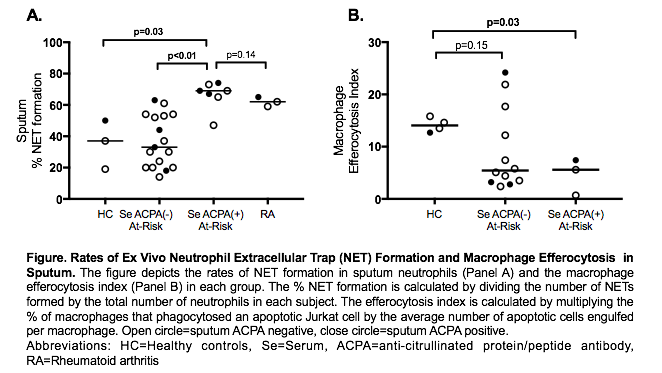Session Information
Date: Sunday, November 5, 2017
Title: Rheumatoid Arthritis – Human Etiology and Pathogenesis Poster I
Session Type: ACR Poster Session A
Session Time: 9:00AM-11:00AM
Background/Purpose: Data support that ACPAs are generated in the lung in RA-free subjects At-Risk of future RA. Our group previously demonstrated a significant positive correlation between sputum ACPA levels and remnants of neutrophil extracellular traps (NETs) in At-Risk subjects (Demoruelle 2017). However, it is unknown if increased sputum NET levels in these subjects is due to aberrant neutrophil function or ineffective macrophage function (e.g. decreased macrophage efferocytosis that is a mechanism of apoptotic cell clearance). Herein, we sought to quantify ex vivo NET formation and macrophage efferocytosis in association with ACPA in the sputum of At-Risk subjects.
Methods: We collected serum and induced sputum from 24 subjects At-Risk for RA based on familial RA or serum ACPA positivity identified through community screenings [17 were serum ACPA- and 7 serum ACPA+ based on commercial CCP3.1 (IgG/IgA, Inova)], 3 healthy Controls and 3 serum ACPA+ classified RA patients. Sputum was tested for ACPA using CCP3.1 ELISA and the cut-off for positivity was determined in a separate healthy control group (N=70). Sputum plugs were processed and incubated for 1 hour without stimulation for NET measurements and a subset (N=15) were also incubated with apoptotic Jurkat cells for efferocytosis assays. The formation of NETs was assessed by fluorescence microscopy with staining for Hoechst 33342, neutrophil elastase and citrullinated histone-H3. Microscopy-based methods were used to quantify the percent of neutrophils demonstrating NET formation and the efferocytosis index for macrophages ingesting apoptotic Jurkats.
Results: NET formation in sputum neutrophils was significantly higher in serum ACPA+ At-Risk subjects compared to Controls (p=0.03) and serum ACPA- At-Risk subjects (p<0.01) (Figure Panel A), although a portion of serum ACPA- At-Risk subjects had elevated rates of sputum NET formation. There was a trend toward a higher prevalence of sputum ACPA positivity in At-Risk subjects with >60% NETosis [4/8 (50%) vs. 3/15 (20%), p=0.18]. There was no difference in NETosis based on smoking history. The efferocytosis index was lower in serum ACPA+ At-Risk subjects compared to Controls (p=0.03, Figure Panel B).
Conclusion: We found that sputum neutrophils in At-Risk subjects exhibit increased NET formation in serologically ACPA+ At-Risk individuals. Furthermore, in these subjects, sputum macrophages exhibited decreased efferocytosis. These findings suggest that enhanced neutrophil NET formation and ineffective macrophage efferocytosis in the lung may both play a role in the development of systemic and potentially local mucosal ACPA generation in subjects At-Risk for RA. Additional studies are needed to determine whether sputum NETs in At-Risk subjects contain unique citrullinated protein cargo as well as whether these processes are aberrant at other mucosal sites.
To cite this abstract in AMA style:
Okamoto Y, Mohning MP, Thomas SM, Visser A, Kelmenson LB, Norris JM, Kaplan MJ, Janssen WJ, Holers VM, Deane KD, Demoruelle MK. Sputum Neutrophils Demonstrate Increased Neutrophil Extracellular Trap Formation in RA-Free Subjects at-Risk of Future RA [abstract]. Arthritis Rheumatol. 2017; 69 (suppl 10). https://acrabstracts.org/abstract/sputum-neutrophils-demonstrate-increased-neutrophil-extracellular-trap-formation-in-ra-free-subjects-at-risk-of-future-ra/. Accessed .« Back to 2017 ACR/ARHP Annual Meeting
ACR Meeting Abstracts - https://acrabstracts.org/abstract/sputum-neutrophils-demonstrate-increased-neutrophil-extracellular-trap-formation-in-ra-free-subjects-at-risk-of-future-ra/

